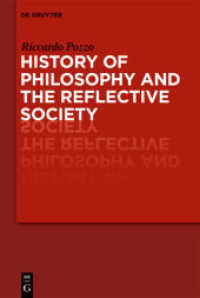- ホーム
- > 洋書
- > 英文書
- > Psychology
Full Description
A New Pluralistic Paradigm for Research is a comprehensive resource that equips a diverse audience with essential research knowledge. 14 informative chapters, organized into two sections, describe a new paradigm, as well as methodologies to research group analytic psychotherapy and different types of groups and populations.
In addition to making group analytic thinking accessible, and offering a practical guide, the Emerging Reality Paradigm promotes the decolonization of research practices, offering an alternative to traditional Western paradigms. Whilst the focus is on a pluralism, readers will also gain valuable insight into both quantitative and qualitative research paradigms. Western and Indigenous thinking is bridged, illustrative examples are interwoven, and real research examples are included, enabling professionals and students to research analytic groups effectively. Engaging text boxes and suggestions for further reading foster a deeper understanding.
This book is ideal for psychotherapists, researchers, students, supervisors, trainees, and seminar leaders, who seek to gain or deepen their knowledge of group analytic research. It serves as an essential guide for anyone interested in analytic groups and the methodologies that inform them.
Contents
General Introduction
Introduction to Section One
Introduction To Section Two
Section 1
1 The Excluding Histories of Philosophy & Science AND Dominance of Positivism Is An Alternative Research Paradigm Needed?
2 Why A Paradigm Shift Is Needed Introducing the Emerging Reality Paradigm (ERP) Part 1
2 Why A Paradigm Shift Is Needed Introducing the Emerging Reality Paradigm (ERP) Part 2
Section 2
3 Learning Traditional Research & Nomenclature Through Group Analysts
4 Diffraction & Quantitative Methods Combining Quantitative Methods in Group Analytic Research with AI
5 Less Frequently Used Methods For Group Analytic Research
6 'Living' Group Analytic Theories To Grasp Related Notions, To Start Theorizing & To Generate Theories
7 The Trouble With Qualitative Methods Is It Possible To Do Qualitative Analysis After Coding In Group Analytic Research?
8 Application of Diverse Analytic Methods to Research Unconscious Group Processes, Sensitive Topics & the Hidden
9 Adopting Philosophical Foundations That Shift The Focus To Diverse Mixed Methods In Group Analytic Research
10 Secondary Data: Analysis Methods for Documentary, Therapy & Supervision Group Research
11 Learning About Archival Research & Research Writing Through Illustrative Examples
12 Child and Adolescents Research & Ethics
13 Researching Median, Large & Consultancy Groups
Concluding Remarks: Every Research Project Matters
Bibliography
Appendix 1: Group Analytic Psychotherapies, Developments & Concepts
Appendix 2: Where group analytic psychotherapy can be situated
Appendix 3: Questionnaires, Software & Resources: Group Questionnaires, Inventories & Tests For Psychotherapy Research
Appendix 4: A Group Analyst's Journey to Master the Basics of Statistics
Appendix 5: Supplement to Chapter 2 Part 2: Development Of Modern Physics & Mechanics
Index
List of figures
1.1 Relation between Individual & Group
1.2 Influences On A Group
1.3 The Matrix, Dynamic (DM) and Foundation (FM) Matrix (see Foulkes, 1948, 2003, Thornton, 2025, Wilke, 2025)
1.4 Critical Realism's 3 Levels of Reality
2.1 Foulkes' 4 Levels (Template adapted from Presentation.com)
4.1 Figure 4.1: Evidence Pyramid, adapted from Ingham-Broomfield (2016) and Wallace et al. (2022)
4.2 Fictitious Flow Diagram
5.1 Development of Group Research (Extracted from Wheelan et al. 2005)
5.2 Fictitious Completed Grid
5.3 Fictitious Graphic Representation of a fictitious Q-set
5.4 Main theoretical division between Approaches (extracted from Rawlings et al. (2023) and Borsboom et al. 2021)
5.5 Conceptualization of Nodes & Social Ties (extracted from Rawlings et al., 2023, pp. 47-9)
5.6 Fictitious Network Graph of Highly Connected Therapy Group with 8 Members
5.7 Procedure involved in a (Social) Network Analysis
5.8 Multilingual Sentiment Analysis Classification (modification of Khurana et al. 2023)
5.9 Capability & Limitation of Machine Learning Algorithms to enable MSA (extracted from Lee et al., 2022 and Wang et al., 2025)
5.10 Deep Learning Models
6.1 Scientific Cyclical Process
6.2 Theoretical Perspectives On Groups (Extracted From Wheelan, 2005 & Barkham et al., 2021)
6.3 Distinctive Attributes & Functions of Living Theory
6.4 Different Versions of Grounded Theory (extracted from Chun Tie et al., 2019)
6.5 Philosophical Differences (extracted from Chun Tie et al., 2019)
6.6: Basic Procedure of Constructivist Grounded Theory (extracted from Charmaz, 2006, 2014, Charmaz & Belgrave, 2015)
7.1 Old & New IPA Terminology
8.1 Manifestations of Transference
9.1 Stages of Data Analysis in line with Bhaskar and procedure extracted from Stuchbury (2021, p. 8)
10.1 Chronogram structuring a group session into 3 phases. Extracted from Cox (1989, p. 43)
10.2 A Group Interaction Chronogram Template for 4 Members
4.A1 Bar Chart
4.A2 Scatterplot
4.A3 'Phallic' regression line graph
4.A4 Whiskers chart
4.A5: IQR
List of tables
5.1 Fictious Correlation Matrix Between Variables
List of boxes
1.1 Critical Theory & Postmodernism
1.2 Social Constructionism & Social Constructivism
1.3 Interpretivism
1.4 Positivism
1.5 Rationalism vs (Logical) Empiricism
1.6 Pragmatism & Mixed Methods
1.7 Critical Realism
3.1 Induction, Deduction & Abduction
3.2 Phenomenological Hermeneutics & Interpretation
3.3 Experiments & Experimentation
3.4 Naturalistic Studies, Field Experiments & Case-control Studies
3.5 Within & Between-Subjects Designs
3.6 Transference & Countertransference
3.7 Participant Observation & Ethnography
3.8 The Case Study & Single Case Design
3.9 Case Studies of Failed Cases
3.10 Unorthodox Techniques
3.11 Non-Experimental, Quasi-Experimental & Experimental Research Designs
4.1 Therapeutic Relationship/Working Alliance & Rupture
5.1 Indicator/Dummy Variable
6.1 Interrater Agreement
6.2 One Possible Procedure







